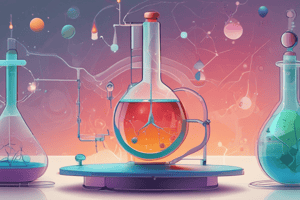Podcast
Questions and Answers
What is the pH of a solution with a hydrogen ion concentration of $10^{-8}$ mol/L?
What is the pH of a solution with a hydrogen ion concentration of $10^{-8}$ mol/L?
- pH = 10
- pH = 7
- pH = 6
- pH = 8 (correct)
What is the definition of a strong acid?
What is the definition of a strong acid?
- A strong acid almost completely dissociates in aqueous solution and produces many H+ ions. (correct)
- A strong acid is a proton acceptor and does not produce H+ ions.
- A strong acid partially dissociates in aqueous solution and produces few H+ ions.
- A strong acid cannot dissociate in aqueous solution and does not produce H+ ions.
What is the definition of a buffer?
What is the definition of a buffer?
- A solution that resists changes in pH when an acid or alkali is added to it. (correct)
- A substance that increases the rate of a chemical reaction without being consumed in the process.
- A substance that completely neutralizes acids to maintain a constant pH.
- A solution that enhances changes in pH when an acid or alkali is added to it.
Which type of acid can be 'breathed off' as gases?
Which type of acid can be 'breathed off' as gases?
What is the normal range for blood pH?
What is the normal range for blood pH?
Flashcards are hidden until you start studying
Study Notes
pH of a Solution
- The pH of a solution with a hydrogen ion concentration of 10^(-8) mol/L is 8.
Acid Types
- A strong acid is an acid that completely dissociates in water, producing a high concentration of hydrogen ions.
Buffer Solutions
- A buffer is a solution that resists changes in pH when an acid or base is added to it.
Acid Characteristics
- Volatile acids, such as carbonic acid and hydrochloric acid, can be 'breathed off' as gases.
Blood pH
- The normal range for blood pH is between 7.35 and 7.45.
Studying That Suits You
Use AI to generate personalized quizzes and flashcards to suit your learning preferences.


